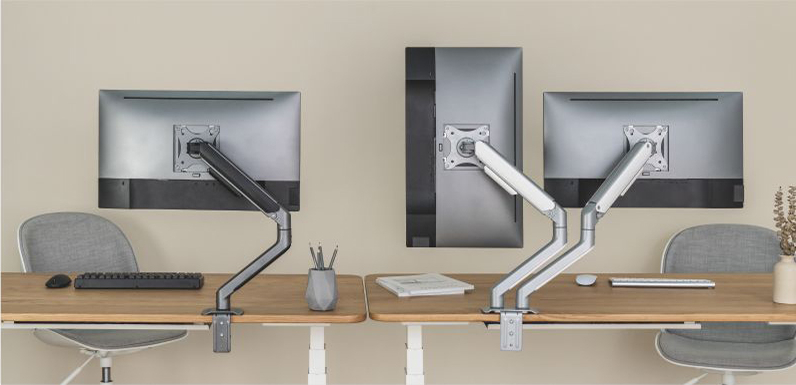Exploring the World of Monitor Mounts: A Comprehensive Guide
In recent years, the monitors have become an essential tool for work, entertainment, and communication in recent years. Your comfort, productivity, and overall experience can be greatly affected by the way you place your monitor, whether you're setting up a home office, gaming setup, or professional studio. In this article, we will introduce you to monitor mounts, which are adaptable solutions that raise your displays to the ideal height, angle, and position. And we'll go over the many types of monitor mounts on the market, their features and benefits, and how to choose the best one for your needs.
Benefits of Monitor Mounts
Before delving into the different types of monitor mounts, it's important to understand the reasons why investing in a monitor mount is beneficial. Here are some compelling reasons:
1. Ergonomic Benefits
Holding your monitor in the proper position helps relieve strain on your shoulders, neck, and eyes. A monitor arm allows you to adjust the height, tilt, and rotation of the screen to achieve the best viewing angles. This improves posture and reduces the possibility of pain or damage from prolonged computer use.
2. Space Optimization
Desk space is important, especially in today's offices where clutter can reduce performance. By hanging your monitor, you can free up important desk space for other necessities such as paperwork, stationery, or extra monitors. This makes your desk cleaner and more organized, which helps you focus on the task at hand without distractions.
3. Versatility and Flexibility
When it comes to screen placement, monitor mounts offer unmatched versatility. Whether you choose a single monitor layout or a multi-monitor system, a monitor mount gives you the flexibility to customize your workspace to suit your tastes and workflow needs. With adjustable arms and articulating brackets, you can quickly and easily reposition your monitor for different tasks, such as gaming, design, or video editing.
4. Better Collaboration
Monitor mounts facilitate screen sharing and collaboration in group settings and conference rooms. You can easily change the angle and orientation of the screen to ensure optimal viewing for all participants by mounting monitors on articulating arms or wall mounts. This improves productivity, teamwork and communication during group discussions or presentations.
5. Cable Management
Disorganized cables can make your office less visually appealing and create a tripping hazard. To keep cables tidy and hidden, many monitor mounts have built-in cable management features such as channels or clips. Not only does this help your setup look better, but it also reduces the possibility of accidents and makes it easier to keep a clean desk.
In summary, a monitor mount is a necessary tool for anyone who spends a significant amount of time working at a computer. From ergonomic benefits to space optimization and increased productivity, the benefits of using a monitor mount are numerous and compelling. By understanding the importance of a monitor stand, you can choose the best type of stand for your needs and preferences.
Types of Monitor Mounts
There are several types of monitor mounts, each with its own unique features and benefits. Choosing the ideal monitor mount for your particular needs and tastes can be made easier if you are aware of the various options available. The following are some of the most popular types of monitor mounts:
1. Monitor Risers
The simplest and most economical choice is a fixed monitor riser, sometimes referred to as a stationary mount. These mounts provide stability and support by firmly attaching your monitor to a specific location on a wall or desk. Although fixed mounts don't offer as much freedom as adjustable options, they work well in scenarios where you don't need to move your monitor much.
2. Gas Spring Monitor Mounts
Gas spring monitor mounts combine the flexibility of articulating arms with the smooth, effortless motion of gas-powered mechanisms. With these mounts, you can easily and quickly change positions because the weight of the monitor is balanced by gas springs. Professionals such as designers, photographers and video editors who require smooth movement and precise positioning are big fans of gas spring mounts.
3. Mechanical Spring Monitor Arms
Known for their stability and durability, mechanical spring monitor mounts are ideal for long-term use. Although they require manual adjustment, these mounts offer precise control to ensure optimal positioning. They are also often more cost effective than gas spring monitor arms.
4. Articulating Monitor Arms
Articulating monitor arms, also known as adjustable arms or monitor brackets, provide maximum flexibility in positioning your display. With multiple points of articulation-including rotation, tilt, and swivel-these mounts allow you to easily change the height, angle, and orientation of your monitor. Articulating arms are perfect for multitasking, teamwork, and dynamic work environments where flexibility is essential.
5. Pole Mounts
A reliable and adaptable way to place monitors on a vertical pole or column is with a monitor arm pole mount. Because these mounts can support one or more monitors, users can arrange their workspace to suit their own needs and tastes. When space is limited or wall or desk mounting is not an option, pole mounts are perfect. Pole mounts are often used in command centers, trading floors and control rooms where users need quick access to multiple screens.
6. Ceiling and Wall Mounts
Monitors can be suspended from the ceiling or mounted directly to a vertical surface with wall and ceiling mounts. These mounts are perfect for spaces with limited floor space or where a sleek, minimalist look is preferred. Wall mounts are ubiquitous in homes, workplaces, and entertainment venues, while ceiling mounts are typically found in conference rooms, auditoriums, hospitals and retail environments.
Whether you choose monitor risers, gas spring mounts, mechanical spring mounts, articulating arms, pole mounts, wall mounts or ceiling mounts, each type offers unique benefits to suit different preferences and needs. Now that we've explored the options available, let's delve into the considerations for choosing the right monitor mount to optimize your setup and productivity.
How to Choose the Right Monitor Mount
Choosing the right monitor mount can make a big difference in your overall comfort and productivity. There are several factors to consider when choosing a monitor mount:
1. Monitor Size and Weight: Make sure the mount is compatible with the size and weight of your monitor.
3. Adjustability: Consider the level of adjustability needed for your workspace, including tilt, swivel, and rotation.
4. Aesthetics: Choose a mount that complements the design of your workspace and enhances its overall aesthetics.
By carefully evaluating these factors and choosing the right type of monitor mount, you can create a comfortable, efficient, and visually appealing workstation that meets your specific needs and enhances your productivity and well-being.







